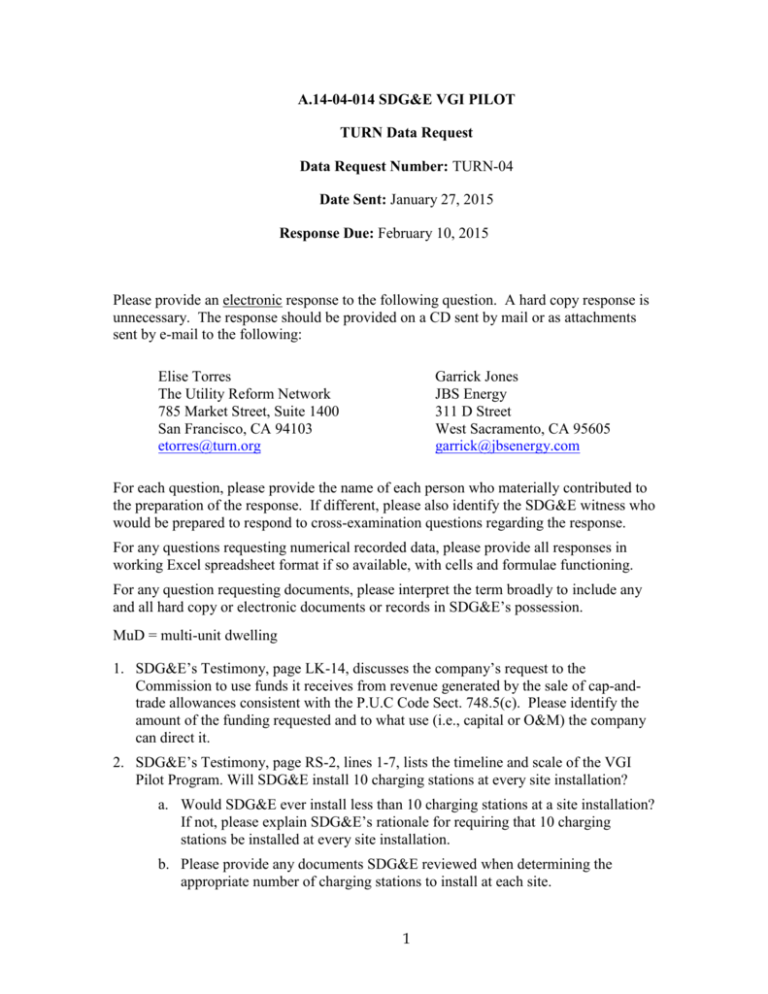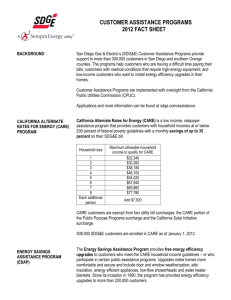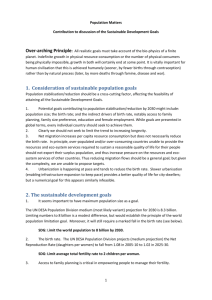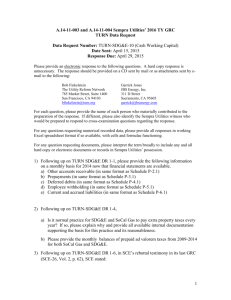TURN-DR-04
advertisement

A.14-04-014 SDG&E VGI PILOT TURN Data Request Data Request Number: TURN-04 Date Sent: January 27, 2015 Response Due: February 10, 2015 Please provide an electronic response to the following question. A hard copy response is unnecessary. The response should be provided on a CD sent by mail or as attachments sent by e-mail to the following: Elise Torres The Utility Reform Network 785 Market Street, Suite 1400 San Francisco, CA 94103 etorres@turn.org Garrick Jones JBS Energy 311 D Street West Sacramento, CA 95605 garrick@jbsenergy.com For each question, please provide the name of each person who materially contributed to the preparation of the response. If different, please also identify the SDG&E witness who would be prepared to respond to cross-examination questions regarding the response. For any questions requesting numerical recorded data, please provide all responses in working Excel spreadsheet format if so available, with cells and formulae functioning. For any question requesting documents, please interpret the term broadly to include any and all hard copy or electronic documents or records in SDG&E’s possession. MuD = multi-unit dwelling 1. SDG&E’s Testimony, page LK-14, discusses the company’s request to the Commission to use funds it receives from revenue generated by the sale of cap-andtrade allowances consistent with the P.U.C Code Sect. 748.5(c). Please identify the amount of the funding requested and to what use (i.e., capital or O&M) the company can direct it. 2. SDG&E’s Testimony, page RS-2, lines 1-7, lists the timeline and scale of the VGI Pilot Program. Will SDG&E install 10 charging stations at every site installation? a. Would SDG&E ever install less than 10 charging stations at a site installation? If not, please explain SDG&E’s rationale for requiring that 10 charging stations be installed at every site installation. b. Please provide any documents SDG&E reviewed when determining the appropriate number of charging stations to install at each site. 1 c. Please provide copies of any reviews, studies, workpapers, business cases that SDG&E produced internally or requested contractors to produce. 3. SDG&E’s Testimony, page RS-11, lines 14-16 states “VGI sites will require a new transformer, and up to 25% of the new electric services will require an upgraded transformer, while the remaining 50% of the new electric services will connect to an existing transformer.” a. Please clarify what this sentence means. Does it mean that 25% of VGI sites that SDG&E chooses would require a new transformer, up to 25% would require an upgraded transformer, and the remaining 50% would connect to an existing transformer? Please provide the alternative explanation if this interpretation is incorrect. b. Does the phrase “up to 25% of the new electric services will require an upgraded transformer” mean that SDG&E would cap the number of VGI sites that require an upgraded transformer to 25% of the total number of sites? Please provide the alternative explanation if this interpretation is incorrect. c. Would SDG&E also cap the number of VGI sites that require a new transformer? If so would it be capped at 25% of the total number of sites? d. If SDG&E would cap the number of VGI sites requiring an upgraded transformer and/or a new transformer, please explain how SDG&E will administer the allowances. e. Will SDG&E prioritize potential VGI sites that would not require upgraded and/or new transformers over those that would? If so, please provide a detailed explanation of the prioritization scheme. If not, why not? f. Why is SDG&E proposing to install VGI-related electric services at locations that require new or upgraded transformers? Please provide a detailed explanation of why SDG&E cannot limit the installations for its pilot program to locations that do not require new or upgraded transformers. g. What is the statistical justification for the requirement that SDG&E installs VGI-related electric services at locations that require new or upgraded transformers? Please provide all studies and/or analysis related to this topic. 4. SDG&E’s Testimony, page RS-15, lines 15-19 states “The charging equipment and cables will be replaced one time during the course of the VGI Pilot Program. Due to expected improvements in EVSE design and longevity, SDG&E expects these replacement units to last 10 years through the end of the VGI Project. The O&M funds for these replacements will be added to the project budget at a 20% annual level over a 5-year time period.” a. How many years does SDG&E expect will make up “the course of the [proposed] VGI Pilot Program” in the context of the sentence spanning lines 15-16. b. Please confirm that SDG&E estimates that it will require two generations of charging equipment and cables to complete the proposed VGI Pilot program. 2 c. Please explain why the charging equipment and cables would need to be replaced during the course of the proposed VGI Pilot program. d. In which year of the proposed Pilot Program would the charging equipment and cables be replaced? e. Why does SDG&E assume that the replacements units would “last 10 years”? Has SDG&E done any research regarding the expected life of charging equipment? If so, please provide any materials SDG&E relied on in making this determination. f. On page RS-15, line 22, SDG&E’s witness states the replacement cost for access control equipment as $14,700. This amount differs significantly from the installation costs for access control equipment, $47,700, listed on page RS-14, line 13. Please explain this discrepancy. g. Please divide all identified capital costs between original and replacement equipment and installation costs in each year of the proposed VGI Pilot program. 5. SDG&E’s Testimony, page RS-16, lines 8-15, discusses customer engagement costs, subsections (b) and (c) respectively list contract labor annually for the first 4 years of the project and annually for years 3 and 4 of the project for the same activities and for the same amount. Please explain why years 3 and 4 would require duplicative contract labor in addition to the contract labor hired for the first four years for the same activities listed in subsection (b). 6. SDG&E’s Testimony, page RS-5, lines 19-21 states, “The VGI [prototype] charging facility has been well received by employees and has helped to refine this VGI Pilot Program proposal.” Please provide copies of all documents and/or analysis that contain a showing of how SDG&E used the VGI prototype charging facility to “refine this VGI Pilot Program proposal.” 7. Regarding the PEV Pricing and Technology study, approved by the CPUC June 2010, Advice Letter 2157-E: a. Please provide a narrative description of the way in which SDG&E used the PEV Pricing and Technology study to inform and/or refine its VGI Pilot Program proposal. b. Please provide copies of all documents and/or analysis that contain a showing of how SDG&E used the PEV Pricing and Technology study to inform and/or refine its VGI Pilot Program proposal. 8. SDG&E’s Testimony, page RS-7, lines 5-18 lists the criteria that SDG&E would use to evaluate and prioritize interested sites for VGI installation. Please explain the order in which the criteria would be utilized in order to prioritize interested sites. a. Please quantify each of the qualitative criteria listed. E.g., although your response should not be limited by this example, if there are ranges of distances between transformer and new service points that are ranked as more desirable than other ranges, what are the ranges and why. Please provide rationale for all quantifications you provide. If quantifications are not available, please 3 provide a detailed explanation regarding why the utility believes that such is not necessary. b. Please identify and explain in detail the rationale for any weighting SDG&E will apply to the listed criteria. c. Line 9 lists “current and expected volume of EV drivers” as one of the criteria that would be used. Please explain how SDG&E would gauge the expected volume of EV drivers? What type of research would be done? Would the site owner need to provide any documentation to prove the current number or EV drivers or to support the expected volume of EV drivers? 9. SDG&E’s Testimony, page RS-9, lines 3-4, states: “SDG&E will develop source selection criteria before the RFP is released to the marketplace.” Please explain the process SDG&E would use to develop source selection criteria. Would the criteria be available for Commission and third-party review prior to their implementation? If not please elaborate as much as possible regarding what the source selection criteria would entail. 10. SDG&E’s Testimony, page RS-12, lines 2-4 states, “The ultimate blend of Level 1 and Level 2 EVSE will be customized to meet specific host site needs, in light of SDG&E’s managed EV charging load opportunities and available electrical capacity.” a. Please explain in detail how SDG&E plans to consider its “managed EV charging load opportunities” when planning for the number of Level 1 and Level 2 EVSE. Please provide any analysis that supports the response to this request and identify any criteria that SDG&E will use for the balancing of customers’ stated preferences and any SDG&E charging load opportunities. b. Please explain in detail how SDG&E plans to consider its “available electrical capacity” when planning for the number of Level 1 and Level 2 EVSE. Please provide any analysis that supports the response to this request and identify any criteria that SDG&E will use for the balancing of customers’ stated preferences and any SDG&E capacity limitations. 11. SDG&E Testimony, p. JBA-3, lines 3-8 states “No escalation factors were applied to third-party vendor costs associated with ongoing O&M because SDG&E intends to enter into fixed price contractual agreements with these vendors. SDG&E also assumes no change to the pricing of Electric Vehicle Supply Equipment component costs. This assumption is supported by current and historical charging station prices provided by Clipper Creek, Inc.” a. Please explain why SDG&E assumes no change to the pricing of EVSE component costs over time. Please include any information provided by Clipper Creek, Inc. b. Why has SDG&E used only one source of cost estimates and why did the company choose Clipper Creek, Inc. as that sole source? 12. SDG&E Supplemental Testimony, page ST-6, lines 7-9 states, “Many recognize that the deployment of electric vehicle charging equipment is falling well behind the pace necessary to meet the Governor’s goal [from Governor’s Executive Order (B-16- 4 2012) of deploying the infrastructure necessary to support up to 1 million electric vehicles by 2020].” a. Please provide references for the contention that “many recognize that the deployment of electric vehicle charging equipment is falling well behind the pace necessary to meet the Governor’s goal… .” b. Please provide the exact reference to the cited goal of “up to 1 million electric vehicles by 2020.” TURN is unable to find such language in the executive order. 13. SDG&E Supplemental Testimony, page ST-44, lines 11-23 lists the following as issues with using an existing power panel to power EVSE: 1) “Existing panels are usually close to being fully subscribed; therefore many otherwise excellent locations for installing charging stations are discarded due to power not being readily available in the existing panel. 2) Even if power is available in the existing panel, in many cases only a small number of EVSE can be fed (which limits future expansion).” a. Please explain the basis of these statements. Also, please provide any studies, reports or other information SDG&E relied on in order to reach these conclusions. 14. SDG&E Supplemental Testimony, page ST-46, lines 11-23 “for the pilot to achieve robust results, the number of VGI facilities considered in the VGI Pilot needs to be sufficiently large enough to ensure a reasonably strong statistical representation of SDG&E circuits in the pilot. Although no two circuits are alike, there are some relevant parameters that help to characterize the population of circuits. The relevant parameters include; type of distribution circuit (e.g., Residential, Commercial, or mixed), solar penetration on the circuit, load factor of the circuit, and peak demand hours of the circuit. These circuit characteristics are expected to impact the calculation of the VGI Rate’s hourly prices (specifically the VGI D-CPP Hourly Adder), across more than 1,000 distribution circuits within SDG&E’s service territory.” a. Please provide any studies, reports or other information SDG&E relied on in making these determinations. Please include, but do not limit your response to, the statistical analysis that SDG&E relied upon. b. Who undertook the statistical analysis and what are their qualifications? 15. Are customers required to have a SDG&E account to use the charging stations installed as part of the VGI Pilot Program? 16. How will the charging stations installed at MuDs be administered? Will all tenants be permitted to charge their EVs at the charging stations? Or will specific charging stations be “assigned” to specific resident(s)? If so, how many residents will share a designated charging station and how will their charging be coordinated? 17. Please provide a copy of all workpapers supporting and related to SDG&E’s testimony. Please provide both PDF and native Excel with working cells versions. 18. Please provide all data requests and responses submitted to date by other parties. 5 19. When does SDG&E expect it will have actionable data to help inform further development of VGI? 20. How has SDG&E collaborated with Southern California Edison (SCE) to devise a pilot that will not duplicate the work that SCE proposes in A.14-10-014? Please provide a detailed explanation. 21. Please provide all studies showing that the promotion of EVs is the most costeffective way to achieve the goals and objectives in the ZEV Action Plan. 22. Regarding the National Renewable Energy Laboratory (NREL): a. Please provide copies of documents, memoranda, presentations, meeting or telephone notes and other memoranda, emails with information related to NREL, or its partners, programs and research that SDG&E has brought to bear in the development of its VGI Pilot program. If SDG&E cannot cite any specific information from NREL programs and research that it has brought to bear in the development of its program, please identify and explain each reason it has not done so. b. Please provide a narrative description of the way(s) in which SDG&E used NREL-produced research and material in the design of its program, if applicable. 23. Is SDG&E aware of any other organization that has tested or is or plans to test improved system efficiency by encouraging customers through price signals to charge vehicles when market prices are low, thereby avoiding charging times of system demand peaks? If so, please identify the organization and provide a brief description of the nature of its work on this or related topics. 24. Is SDG&E aware of any other organization that has tested or is or plans to test and/or develop data concerning technology that efficiently integrates EV charging with the grid and/or explores EV energy storage capabilities. If so, please identify the organization and provide a brief description of the nature of its work on this or related topics. 25. Is SDG&E aware of any other organization that has tested or is or plans to test customer response to grid-integrated EV charging? If so, please identify the organization and provide a brief description of the nature of its work on this or related topics. 26. To SDG&E’s knowledge, are there any other organizations that have used or are using or plan to use the data SDG&E produced in SDG&E’s PEV Pricing and Technology study as a starting point for investigations of their own? If so, please identify the organization, identify the name of the investigation, and provide a brief description of the nature of the investigation. 27. Will SDG&E attempt to address any questions about the appropriateness and/or desirability of Level 1 vs. Level 2 vs. fast charging in its proposed pilot? a. If so, what are the specific questions SDG&E would address and how does it propose to address them? If not, why not? 6 b. Would SDG&E consider the impact of residential charging availability/unavailability for potential EV drivers on the workplace results? Why or why not? Please provide a detailed explanation. 7






